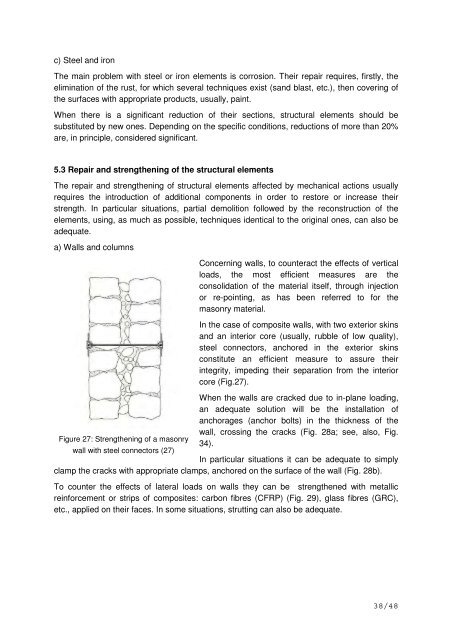Guide for the Structural Rehabilitation of Heritage ... - Test Input
Guide for the Structural Rehabilitation of Heritage ... - Test Input
Guide for the Structural Rehabilitation of Heritage ... - Test Input
Create successful ePaper yourself
Turn your PDF publications into a flip-book with our unique Google optimized e-Paper software.
c) Steel and ironThe main problem with steel or iron elements is corrosion. Their repair requires, firstly, <strong>the</strong>elimination <strong>of</strong> <strong>the</strong> rust, <strong>for</strong> which several techniques exist (sand blast, etc.), <strong>the</strong>n covering <strong>of</strong><strong>the</strong> surfaces with appropriate products, usually, paint.When <strong>the</strong>re is a significant reduction <strong>of</strong> <strong>the</strong>ir sections, structural elements should besubstituted by new ones. Depending on <strong>the</strong> specific conditions, reductions <strong>of</strong> more than 20%are, in principle, considered significant.5.3 Repair and streng<strong>the</strong>ning <strong>of</strong> <strong>the</strong> structural elementsThe repair and streng<strong>the</strong>ning <strong>of</strong> structural elements affected by mechanical actions usuallyrequires <strong>the</strong> introduction <strong>of</strong> additional components in order to restore or increase <strong>the</strong>irstrength. In particular situations, partial demolition followed by <strong>the</strong> reconstruction <strong>of</strong> <strong>the</strong>elements, using, as much as possible, techniques identical to <strong>the</strong> original ones, can also beadequate.a) Walls and columnsConcerning walls, to counteract <strong>the</strong> effects <strong>of</strong> verticalloads, <strong>the</strong> most efficient measures are <strong>the</strong>consolidation <strong>of</strong> <strong>the</strong> material itself, through injectionor re-pointing, as has been referred to <strong>for</strong> <strong>the</strong>masonry material.In <strong>the</strong> case <strong>of</strong> composite walls, with two exterior skinsand an interior core (usually, rubble <strong>of</strong> low quality),steel connectors, anchored in <strong>the</strong> exterior skinsconstitute an efficient measure to assure <strong>the</strong>irintegrity, impeding <strong>the</strong>ir separation from <strong>the</strong> interiorcore (Fig.27).When <strong>the</strong> walls are cracked due to in-plane loading,an adequate solution will be <strong>the</strong> installation <strong>of</strong>anchorages (anchor bolts) in <strong>the</strong> thickness <strong>of</strong> <strong>the</strong>wall, crossing <strong>the</strong> cracks (Fig. 28a; see, also, Fig.Figure 27: Streng<strong>the</strong>ning <strong>of</strong> a masonry34).wall with steel connectors (27)In particular situations it can be adequate to simplyclamp <strong>the</strong> cracks with appropriate clamps, anchored on <strong>the</strong> surface <strong>of</strong> <strong>the</strong> wall (Fig. 28b).To counter <strong>the</strong> effects <strong>of</strong> lateral loads on walls <strong>the</strong>y can be streng<strong>the</strong>ned with metallicrein<strong>for</strong>cement or strips <strong>of</strong> composites: carbon fibres (CFRP) (Fig. 29), glass fibres (GRC),etc., applied on <strong>the</strong>ir faces. In some situations, strutting can also be adequate.38/48
















